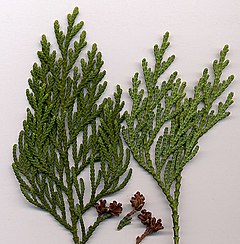| Revision as of 22:16, 20 January 2008 editRG2 (talk | contribs)13,304 editsm spacing← Previous edit | Revision as of 23:40, 20 January 2008 edit undoNumber48 (talk | contribs)141 edits added reference & requested citationNext edit → | ||
| Line 48: | Line 48: | ||
| The foliage of thujas is rich in ], and was used by ] and early European explorers as a cure for ]. | The foliage of thujas is rich in ], and was used by ] and early European explorers as a cure for ]. | ||
| Oil of thuja is often quoted as an herbal remedy to be used topically to aid in the treatment of ], ] or ]. However, clinical evidence for this action is lacking. | Oil of thuja is often quoted as an herbal remedy to be used topically to aid in the treatment of ], ] or ]. Thuja is also used in ] to treat a variety of physiological and psychological conditions.<ref name=BHA>British Homeopathic Association:</ref> However, clinical evidence for this action is lacking.{{fact}} | ||
| ==References== | ==References== | ||
Revision as of 23:40, 20 January 2008
| Thuja | |
|---|---|

| |
| Thuja standishii foliage and cones | |
| Scientific classification | |
| Kingdom: | Plantae |
| Division: | Pinophyta |
| Class: | Pinopsida |
| Order: | Pinales |
| Family: | Cupressaceae |
| Genus: | Thuja L. |
| Species | |
|
Thuja koraiensis | |
Thuja (pronounced "thoo-ya" or "thoo-ja") is a genus of coniferous trees in the Cupressaceae (cypress family). There are five species in the genus, two native to North America and three native to eastern Asia.
They are commonly known as arborvitae (from Latin for tree of life) or thujas; several species are widely known as cedar but because they are not true cedars (Cedrus) it has been recommended to call them redcedars or whitecedars.
They are evergreen trees growing to 10–60 m tall, with stringy-textured reddish-brown bark. The shoots are flat, with side shoots only in a single plane. The leaves are scale-like 1–10 mm long, except young seedlings in their first year, which have needle-like leaves. The scale leaves are arranged in alternating decussate pairs in four rows along the twigs. The male cones are small, inconspicuous, and are located at the tips of the twigs. The female cones start out similarly inconspicuous, but grow to about 1-2 cm long at maturity when 6–8 months old; they have 6-12 overlapping, thin, leathery scales, each scale bearing 1–2 small seeds with a pair of narrow lateral wings.
- Species
- Thuja koraiensis - Korean Thuja
- Thuja occidentalis - Eastern Arborvitae, Northern Whitecedar
- Thuja plicata - Western Redcedar
- Thuja standishii - Japanese Thuja
- Thuja sutchuenensis - Sichuan Thuja
A hybrid between T. standishi and T. plicata has been named as the cultivar Thuja 'Green Giant'.
Another very distinct and only distantly related species, formerly treated as Thuja orientalis, is now treated in a genus of its own, as Platycladus orientalis. The closest relatives of Thuja are Thujopsis dolabrata, distinct in its thicker foliage and stouter cones, and Tetraclinis articulata, distinct in its quadrangular foliage (not flattened) and cones with four thick, woody scales.
Ecology
Thuja species are used as food plants by the larvae of some Lepidoptera species including Autumnal Moth, The Engrailed and Juniper Pug. The foliage is also readily eaten by deer, which where deer population density is high can adversely affect the growth of young trees.
Uses
They are widely grown as ornamental trees, and extensively used for hedges. The cultivar 'Green Giant' is popular as a very vigorous hedging plant, growing up to 70–80 cm/year when young.
The wood is light, soft and aromatic. It can be easily split and resists decay. The wood has been used for many applications from making chests that repel moths to shingles. Thuja poles are also often used to make fence posts and rails. The wood of Thuja plicata is commonly used for guitar soundboards.
The foliage of thujas is rich in Vitamin C, and was used by Native Americans and early European explorers as a cure for scurvy.
Oil of thuja is often quoted as an herbal remedy to be used topically to aid in the treatment of HPV, genital or common warts. Thuja is also used in homeopathy to treat a variety of physiological and psychological conditions. However, clinical evidence for this action is lacking.
References
- ^ Farjon, A. (2005). Monograph of Cupressaceae and Sciadopitys. Royal Botanic Gardens, Kew. ISBN 1-84246-068-4
- Gymnosperm Database: Thuja
- Kelsey, H. P., & Dayton, W. A. (1942). Standardized Plant Names, second edition. American Joint Committee on Horticultural Nomenclature. Horace McFarland Company, Harrisburg, Pa.
- British Homeopathic Association: